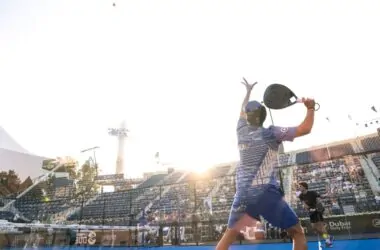So, you've heard about padel and want to know how to play? Let's get right to it. At its core, padel is a fast-paced, social racket sport. It's always played in doubles on an enclosed court where you serve underhand and, here's the fun part, can play the ball off the surrounding glass walls.
Think of it as a dynamic blend of tennis and squash. It’s incredibly fun and, best of all, remarkably easy to learn.
Your First Experience on the Padel Court
Welcome to the world of padel! This is a game that perfectly mixes strategy, social fun, and some truly exhilarating rallies into one seriously addictive package. Unlike tennis, which can feel intimidating for newcomers, padel is famous for being incredibly welcoming. The smaller court, the gentle underhand serve, and the use of walls mean you can grab a racket and start having a blast from your very first session.
And this isn't some niche hobby anymore. Padel has absolutely exploded in popularity, transforming from a regional favorite into a full-blown global phenomenon.

Buy the best padel gear to level up your next game!
CHECK OUT this deal from Padel Market!Get ready to take your game to the next level with the latest padel gear from Padel Market! Fast EU and Worldwide Shipping
The sport is now played in over 130 countries, with participation surging from an estimated 12 million players in 2014 to approximately 30 million today. That’s a massive 2.5 times increase in just a decade, which really shows how much people are loving this game. Learn more about padel's impressive global statistics and its journey to mainstream success.
Why Is Padel So Popular?
A huge part of its appeal is how social it is. Since it's always played in doubles, communication and teamwork are just as crucial as hitting a perfect shot. You're constantly talking and strategizing with your partner, which creates a fun, collaborative vibe that works for all ages and skill levels. In fact, over 70% of players are older than 25, and about 40% are women, highlighting just how diverse and inclusive the community is.
Getting Ready for the Game
Before you jump on the court for the first time, a little prep can go a long way. Padel involves a lot of quick changes in direction and rotational movements. Understanding how to build core strength and flexibility will make a huge difference. For example, learning why athletes need pilates mat training can give you some great ideas for improving the specific muscles you'll use in a match.
This accessibility has fueled a massive construction boom, with new venues popping up everywhere, making it easier than ever to find a court. You can see this trend firsthand with the rise of dedicated facilities. For a great example, check out the story behind the popular Padel Haus in Williamsburg.
This guide is here to get you comfortable with the basics before you even step on the court. We’ll walk through the unique elements, like the glass walls and that all-important underhand serve, setting you up for a smooth transition into understanding the rules, gear, and strategy.
Choosing Your Gear and Understanding the Court
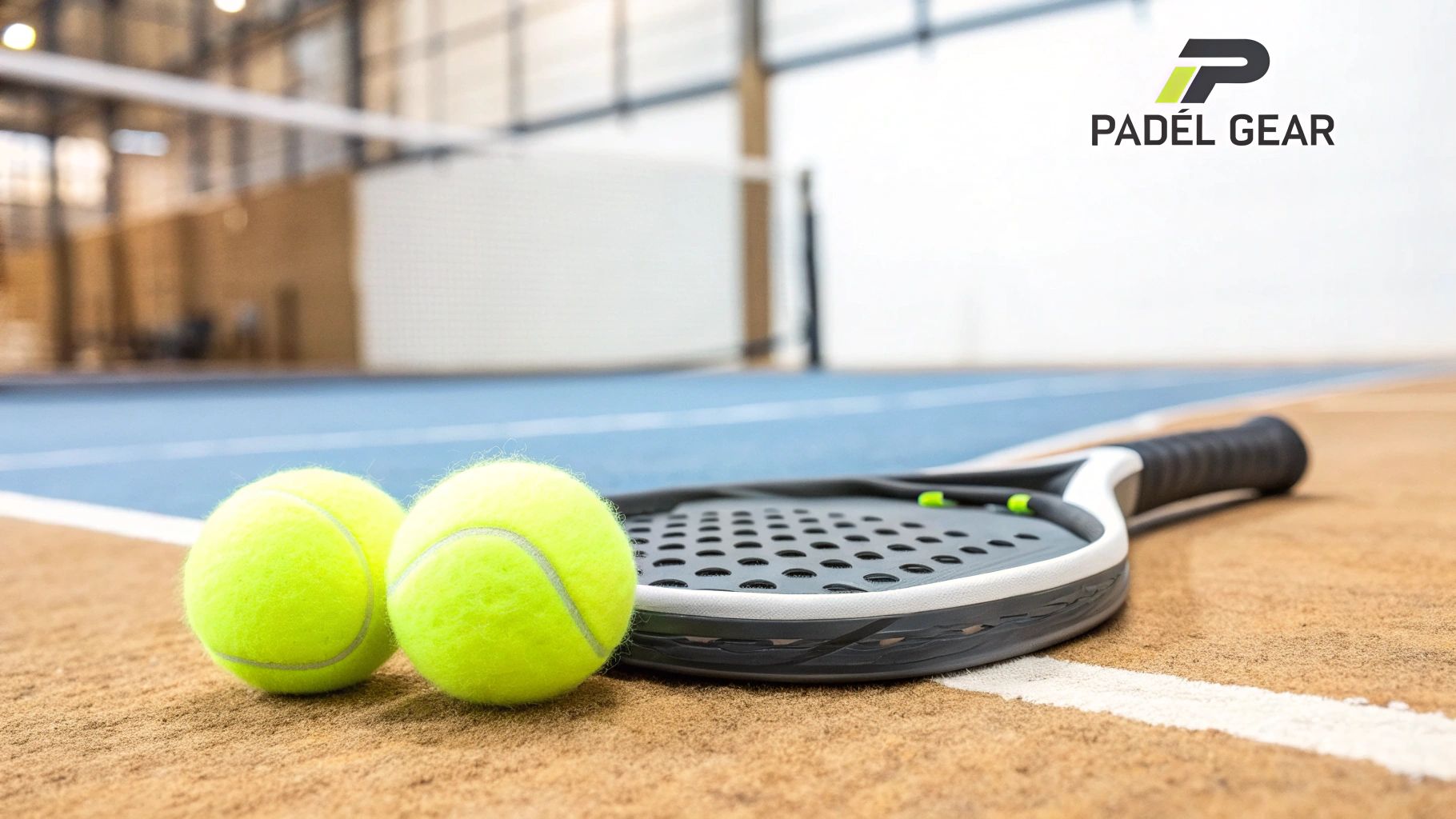
Before you dive into your first rally, you need to get your kit sorted and understand the battlefield. Getting the right gear isn’t just about looking the part; it's about making your first steps into padel as fun and pain-free as possible.
The great news? You don't need a mountain of equipment to start. For now, just focus on the essentials: a racket, the right balls, and a good pair of shoes. Each one is designed specifically for the unique demands of this game.
Selecting Your First Padel Racket
Your racket, or pala, is your most critical piece of equipment. Unlike tennis rackets, padel rackets are solid, don't have strings, and are covered in small holes. For anyone just starting out, a round-shaped racket is almost always the way to go.
A round racket has its weight balanced closer to the handle, which gives it a huge, forgiving sweet spot right in the middle. This translates to maximum control, which is exactly what you need while you're still getting the hang of the basic shots. You'll see diamond-shaped rackets out there, but those are built for power and are much less forgiving if you don't hit the ball perfectly.
Plenty of top brands have fantastic entry-level rackets. If you're curious about the latest gear and what's new, it's worth checking out updates from major players like Adidas Padel.
Padel Balls and Proper Footwear
It’s a classic rookie mistake: thinking you can just grab a can of tennis balls. While they look alike, padel balls have lower internal pressure. This makes them a little less bouncy, which slows the game down just enough to give you more time to react and set up for your next shot—a massive advantage when you're new.
Your shoes are just as crucial. Padel is all about sharp pivots, quick sprints, and a ton of lateral movement. Your trusty running shoes just don't have the side-to-side support you need, which is a fast track to a rolled ankle. You'll want to find shoes made specifically for padel or, at the very least, clay-court tennis. They have a distinct herringbone pattern on the sole that provides the perfect grip on the sandy, artificial turf.
A quick tip from experience: Don't skimp on your shoes. Investing in proper footwear from the start will not only improve your movement on the court but also significantly reduce the chance of slips and injuries.
To make things simple, here's a quick checklist of the gear you'll need for your first game.
Beginner Padel Equipment Checklist
| Equipment | What to Look For (Beginner Focus) | Why It's Important |
|---|---|---|
| Padel Racket | Round-shaped head, lightweight | Maximizes control and provides a large, forgiving sweet spot. |
| Padel Balls | Balls specifically labeled for padel | Lower pressure makes them less bouncy, slowing the game down. |
| Padel Shoes | Herringbone sole pattern, good lateral support | Prevents slips on sandy turf and protects ankles during side-to-side moves. |
Getting these three basics right will set you up for a much better experience on the court.

Buy the best padel gear to level up your next game!
CHECK OUT this deal from Padel Market!Get ready to take your game to the next level with the latest padel gear from Padel Market! Fast EU and Worldwide Shipping
A Tour of the Padel Court
Now that your gear is sorted, let's get you acquainted with your new playground. A padel court is a 20-meter long by 10-meter wide rectangle, fully enclosed by glass walls and metal mesh fencing. Knowing how to use this enclosure is the secret sauce of the game.
The court is split by a net that's a bit lower than a tennis net, sitting at 0.88 meters high in the center. The lines you see on the court? They only matter for one thing: the serve. That box you have to serve into is marked by the service line (running parallel to the net) and the center line.
But the walls are where the real fun begins. The back walls and parts of the side walls are made of tempered glass. The magic rule is that you can let the ball hit these walls on your side after it has bounced once on the ground. This gives you a second chance to return it. Start thinking of the walls as your teammates; playing the ball off the glass is a core part of padel strategy.
This unique court design is one of the reasons padel is exploding globally. In just one year, an incredible 3,282 new clubs opened worldwide, adding over 7,100 courts and pushing the global total past 50,000. It's a testament to how accessible and addictive this sport truly is.
Making Sense of Padel Rules and Scoring
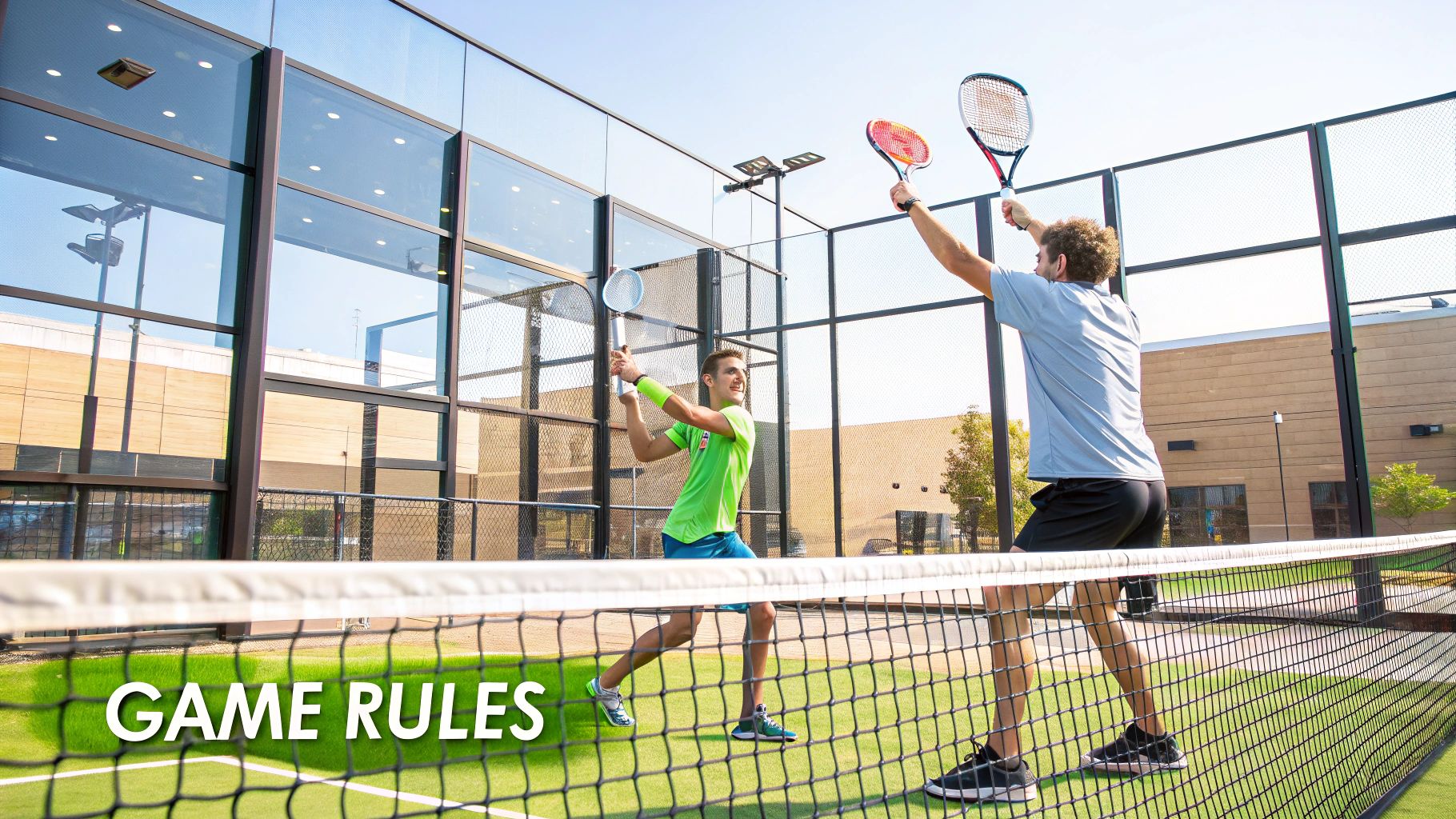
Okay, let's get the rules and scoring down so they feel like second nature. At first glance, some parts might seem a little confusing, but the logic behind it all is what creates those thrilling, strategic rallies that make padel so addictive. Once you grasp the fundamentals, you'll be on the court playing with confidence.
The whole game kicks off with the serve, which has its own unique flair compared to other racket sports. Getting this part right is your first real step to playing padel properly.
The Underhand Serve
Forget the powerful, over-the-top serves you see in tennis. The padel serve is a different beast entirely—it's always underhand. The goal here isn’t to blast an ace past your opponent but to start the point with control and a bit of tactical placement.
Here’s the breakdown for a legal serve:
- Bounce it first. You have to let the ball bounce one time behind the service line before you hit it.
- Keep it low. Your contact with the ball must be at or below your waist. Hitting it above the waist is an instant fault.
- Aim diagonally. Just like tennis, you’re serving into the service box that's diagonally across the court from you.
- Feet behind the line. At least one of your feet has to stay on the ground behind the service line as you make contact.
You get two shots at a legal serve. A fault happens if you swing and miss, hit the ball into the net, or if it lands outside the correct service box. If you fault twice in a row, you lose the point.
Playing the Point and Using the Walls
Once the serve is in, the real fun starts. You win a point if the ball bounces twice on your opponent's side or if they smack the ball into the net. This is where the glass walls—padel's signature feature—come into play and completely change the game.
After the ball bounces once on your side, you can let it rebound off the back or side glass walls before you hit it back. This is a fundamental piece of padel strategy.
Think of the walls as your best friend, not an obstacle. Using the back wall buys you precious time to set up your shot and can flip a defensive scramble into an offensive attack. It's a total game-changer once you get the hang of it.
There are a few key rules to remember about the walls, though:
- You can hit the ball after it bounces on the court and then comes off the glass walls on your side.
- You cannot hit a volley (a shot without a bounce) directly into your opponent's glass walls. The ball must bounce on their court first. Hitting their wall directly is a fault.
- The wire mesh fence is a no-go zone. If the ball hits the mesh on your side before you return it, you lose the point.
These rules are what create those incredible, long rallies and reward smart, tactical play over just raw power. For an even deeper dive, you can explore the official rules of padel.
How Padel Scoring Works
If you've ever seen a tennis match, you're in luck—the scoring in padel is identical. This familiarity makes it incredibly easy for new players to pick up.
Points are called out as 15, 30, and 40.
- First point won: 15
- Second point won: 30
- Third point won: 40
- Fourth point won: Game
Now, if both teams get to 40, the score is called deuce. From here, a team has to win two points in a row to take the game. The first point after deuce is called advantage. If the team with the advantage wins the next point, they win the game. But if they lose it, the score snaps right back to deuce.
Winning Sets and Matches
To win a set, a team must win at least six games and be ahead by two games (for example, 6-4 or 6-3). If the score gets to 6-5, the set continues. If the leading team wins that next game, they win the set 7-5.
But what if the score gets tied at 6-6? That's when you play a tie-break to decide the set. A tie-break is a race to seven points, and just like with games, you have to win by a margin of two. Most matches are played as the best of three sets, so the first team to win two sets wins the entire match.
Executing The Fundamental Padel Shots
Alright, you've got the rules and scoring down. Now for the fun part—actually hitting the ball. This is where you really start to feel the game. The biggest mental shift from a sport like tennis is that padel isn't about raw power. It's a game of chess, not checkers. Finesse, patience, and smart shot placement will win you far more points than trying to blast the ball past your opponents.
Let's dive into the essential shots you'll need to build a solid foundation.
The Controlled Underhand Serve
As we mentioned, the serve in padel is just about starting the point. You're not looking for aces here. The goal is to get the rally started in a way that gives your team an advantage, usually by getting you and your partner to the net.
Remember the two golden rules: you must bounce the ball once behind the service line, and your point of contact with the racket has to be at or below your waist. A great way to practice is to just grab a bucket of balls and serve cross-court into the service box. Don't even think about speed. Focus on depth—a deep serve forces your opponent back and gives them fewer angles to work with.
Mastering Your Groundstrokes
Your forehand and backhand are your workhorse shots, the ones you'll hit most often in any rally. The single most important piece of advice I can give you is to keep your swing short and compact. The court is small, and the ball comes back fast. There's simply no time for a big, looping tennis-style swing.
- Forehand: As the ball approaches, get your body turned, take a short backswing, and make contact out in front of you. Think of it as a firm push rather than a massive hit.
- Backhand: The principle is the same, whether you use one hand or two. Get your shoulders turned, keep the swing tight, and meet the ball in front. Many beginners find a two-handed backhand gives them a bit more stability and control.
Your primary goal with groundstrokes is to hit the ball deep into the opponent's court. This keeps them on the defensive and creates the space you need to advance to the net—the power position in padel.
Defending with the Bandeja and Vibora
Sooner or later, your opponents are going to try and push you off the net by hitting a lob over your head. In tennis, your first instinct would be to turn and smash it. In padel, we have much smarter, more strategic options: the bandeja (Spanish for "tray") and the vibora (Spanish for "viper").
These are the signature shots of the game. They aren't meant to be aggressive winners. Instead, they're defensive overheads designed to keep the ball low and skidding after the bounce, making it incredibly difficult for your opponents to launch an attack.
Pro Tip: The easiest way to think about the bandeja is as a high, sideways slice. As the lob goes over you, turn sideways, raise your racket high and to the side (like you're holding a tray of drinks), and slice across the side of the ball. You want it to land deep in the corner and stay low.
Playing Volleys at the Net
If you want to win points, you have to control the net. And to control the net, you need a solid volley. Once again, the key is simplicity. A padel volley has almost no backswing. It’s more of a block or a punch, using the power from your opponent’s shot.
Keep your racket up and ready in front of your body. As the ball comes toward you, step into it and simply punch or block it back, directing it into an open part of the court. A great drill is to have your partner just feed you balls at the net while you practice blocking them to the left, right, and center.
This table breaks down the main shots and when you'll want to use them in a real match situation.
Key Padel Shots and When to Use Them
| Shot Name | Main Purpose | Best Situation to Use It |
|---|---|---|
| Groundstroke | Maintain the rally, push opponents back. | When the ball bounces in front of you during a rally. |
| Serve | Start the point under control. | At the beginning of every point. |
| Volley | Control the net, finish the point. | When you are positioned at the net and the ball comes to you in the air. |
| Bandeja | Defend against a lob, maintain net position. | When an opponent hits a high, deep lob over your head. |
| Vibora | A more aggressive version of the bandeja to add pressure. | Against a slightly shorter lob, aiming for a fast, skidding bounce. |
| Wall Shot | Turn defense into offense, gain more time. | When the ball bounces and then hits the back or side glass. |
Mastering these shots will give you a fantastic toolkit for handling almost any situation on the court.
Using the Glass Walls to Your Advantage
This is what makes padel truly unique. Letting the ball go past you and hit the back wall isn't a sign of weakness—it's a fundamental strategy. It buys you time, allows you to get into a better position, and can instantly turn a defensive situation into an offensive one.
Learning to read the rebound off the glass is a skill that just takes practice. A simple way to start is to have a partner stand at the net and gently feed you balls. Let the ball bounce, hit the back glass, and then practice hitting your shot as it comes off the wall. Pay attention to how the angle and speed change the rebound. Before long, you'll feel completely comfortable letting balls go past you, knowing the wall is your best friend.
This image really drives home why the walls are so important.
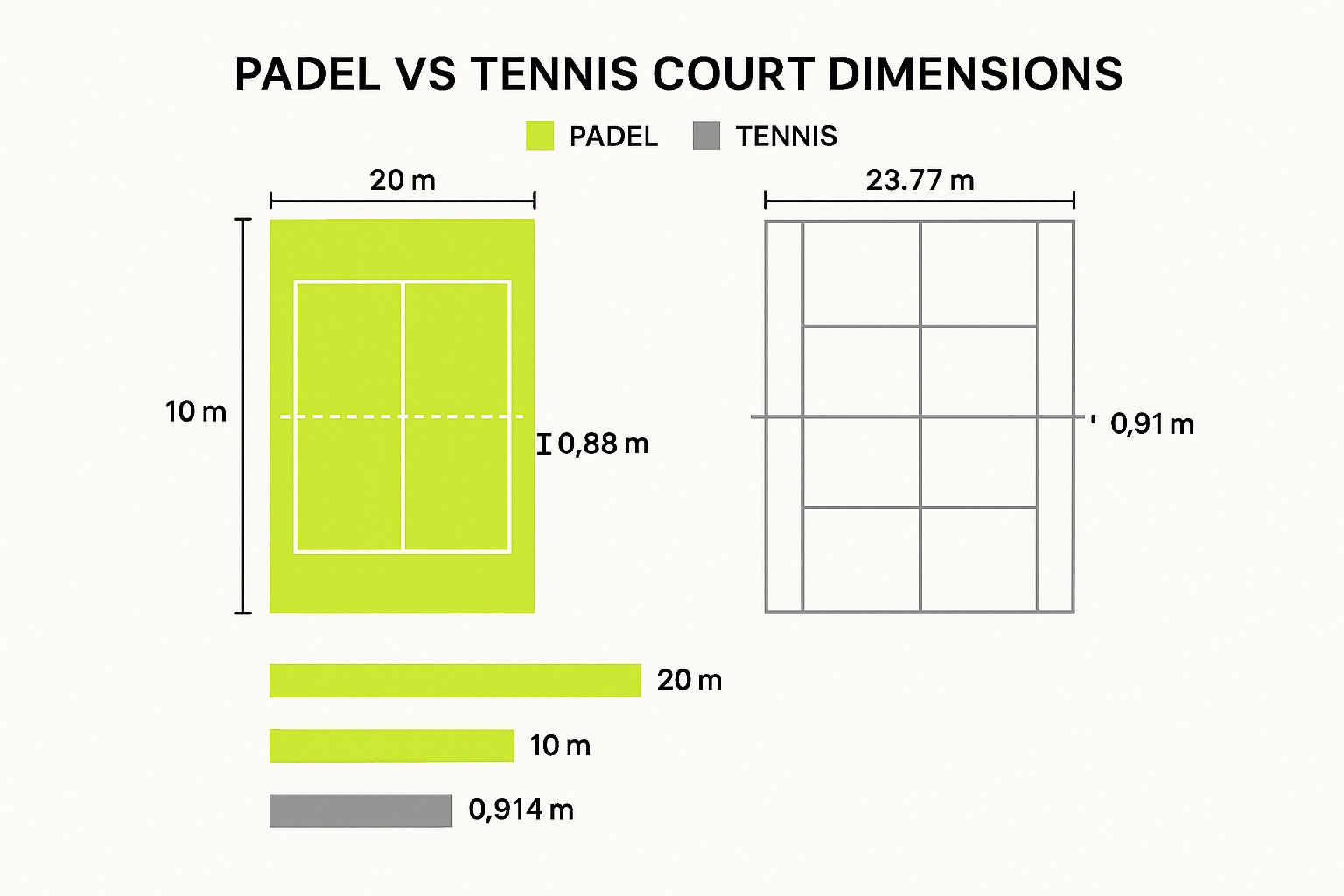
You can see how much smaller the padel court is. This enclosed space is precisely what makes wall play and quick, strategic rallies the heart of the game.
Beginner Court Positioning and Team Tactics
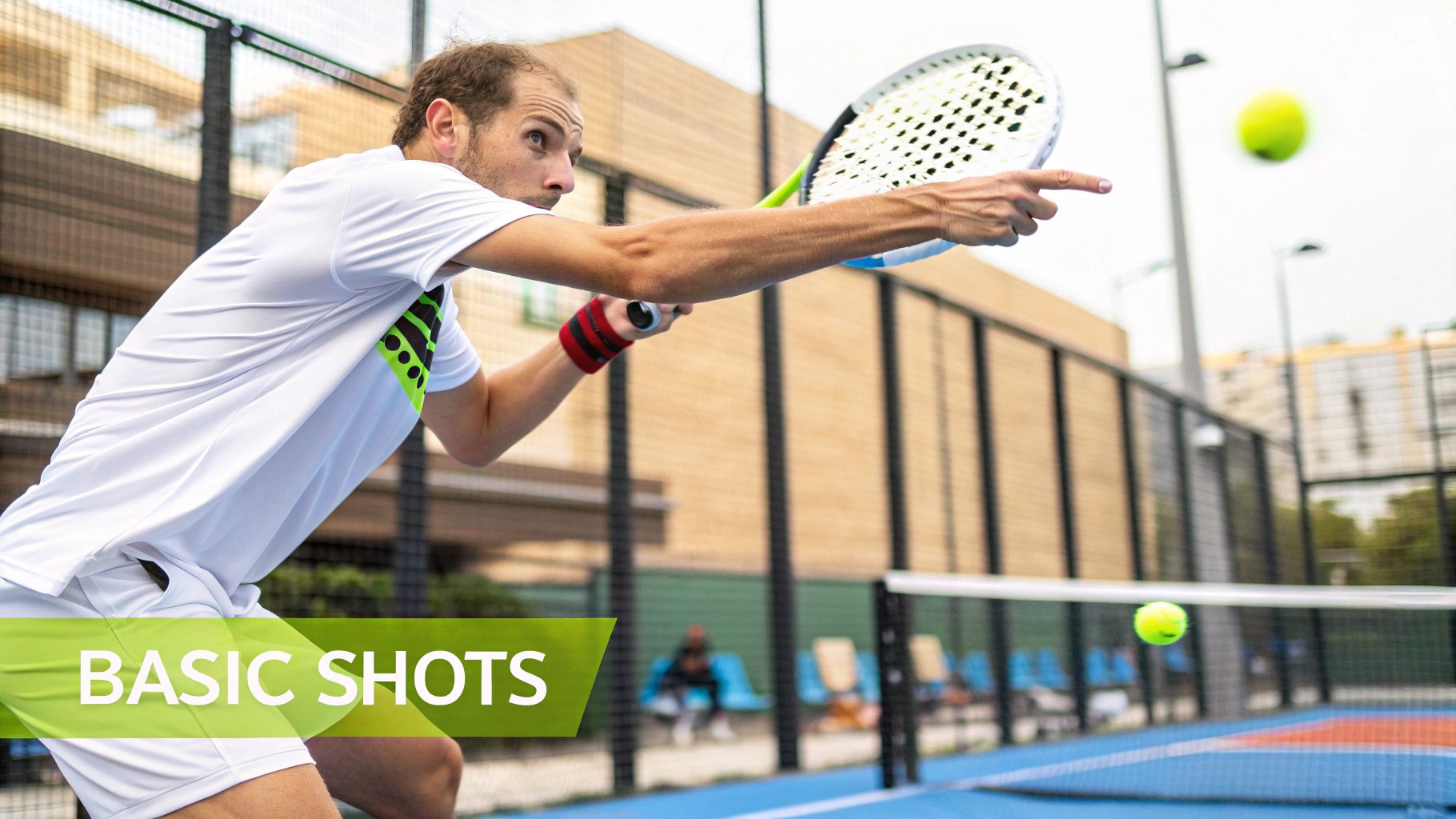
Padel is a game of partnership, first and foremost. While you absolutely need to master your individual shots, it's the way you and your partner move and communicate that really makes the difference. I’ve seen countless matches where smart positioning and teamwork easily beat raw, uncoordinated power.
This is where we shift from thinking about your game to thinking about our game. Let’s dive into where you need to be on the court, how to move like you’re tied together with an invisible string, and the simple tactics that will start winning you matches.
Finding Your Home Base
Think of your positioning on the court as a constant dance. You and your partner have to move in sync, controlling space and reacting as a single unit. Everything starts from your home base, which is different depending on whether you’re serving or returning.
-
Serving Team: Once the serve is in, your mission is to get to the net. Your ideal home base is a few feet back from the net. This lets you cut off angles, hit aggressive volleys, and keep your opponents pinned to the back of the court.
-
Returning Team: When you’re receiving serve, your home base is much deeper, behind the service line. This gives you precious extra time to read the serve and handle those tricky balls that bounce off the back glass.
This basic setup—one team at the net, one team at the back—is the foundation of almost every rally. The team controlling the net usually controls the point.
The golden rule in padel is to win control of the net. From the net, you have all the attacking angles and can end points decisively. When you're stuck at the back, your job is to defend smart and look for an opportunity to steal the net back.
Moving as a Cohesive Pair
The number one mistake I see new players make is moving independently. It's a classic error. If your partner moves up, you have to move up with them. If a lob forces them back, you must retreat as well. Imagine a rope connects you and your partner—your goal is to keep it taut, maintaining a consistent distance.
Moving together like this prevents huge, inviting gaps from opening up on your side. If one of you is at the net and the other is lingering by the back wall, you've just given your opponents a massive, easy target right down the middle. Close those holes by moving as a single unit, and you’ll instantly be a tougher team to score against.
The Power of Communication
You’re not a mind reader, and neither is your partner. Communication is the glue that holds your game together. You don’t need a secret codebook—just a few simple words can eliminate all kinds of confusion and stop you from clashing rackets.
Essential Communication Cues:
- "Mine!" or "Yours!": The most important calls in padel. Yell "mine!" early and with confidence for any ball you feel you can handle. It tells your partner to get out of the way.
- "Wall!": Call this out when a ball is heading for the back or side glass and you want your partner to let it rebound. It's a clear signal to not attempt a difficult, off-balance shot.
- "Middle!": A great reminder for both of you to cover the center of the court, which is often the most vulnerable spot.
Consistent, clear talk builds trust on the court. It lets you play faster, more instinctively, and ultimately, better as a team.
Simple Tactics That Win Points
You don't need a complex playbook to be effective, especially when you’re starting out. Focus on these three simple but incredibly powerful tactics.
- Aim Down the Middle: It's the highest percentage shot in the game. Hitting down the middle often creates confusion over which opponent should play the ball, forcing a weak return or an error.
- Use the Lob to Reset: Feeling the pressure? Under attack? A high, deep lob is your best friend. It’s the ultimate "get out of jail free" card, forcing your opponents away from the net and giving you time to recover your position.
- Learn Patience Over Power: Fight the urge to smash every ball into oblivion. More often than not, the patient team that focuses on keeping the ball in play will win by simply waiting for the other team to make a mistake.
As players get better, they naturally want to test these skills in a more competitive setting. Padel has seen an incredible boom in organized play. In the first half of a recent year, a record 132 international padel tournaments were held, marking an 86% increase from the year before. You can explore the explosive international growth of padel and see how this tournament structure helps players master the tactical side of the game.
Common Padel Questions Answered
Even after you start getting a feel for the game, a few questions always pop up. It's totally normal. Certain situations arise mid-match that can leave you and your partner shrugging at each other. This section is here to tackle those common "what if" scenarios head-on.
Think of this as your go-to guide for those early days. We'll clear up the most frequent points of confusion, from what not to do on the court to how to find a regular group to play with. Getting these answers now means you can spend less time guessing and more time just enjoying the game.
What Is the Biggest Mistake Beginners Make?
By far, the most common mistake I see new players make is swinging way too hard, like they're trying to hit a tennis forehand winner. Padel is a game of control, patience, and placement—it’s not about overpowering your opponents. Trust me, you'll win far more points with a well-placed, softer shot than by trying to smash every single ball. A short, compact swing is your best friend here.
Another classic error is forgetting to use the walls. So many beginners instinctively try to volley every ball or hit it before it touches the back glass. But letting the ball rebound off the wall is a game-changer. It gives you more time, gets you into a better position, and often sets you up for a much easier return.
The moment you start seeing the back wall as your ally instead of an obstacle is the moment your game will truly begin to improve. Focus on consistency over raw power and let the walls do some of the work for you.
Can I Play Padel by Myself?
While the official rules and the entire strategy of the sport are built around doubles (two vs. two), you can technically play singles for practice. But you'll almost never see it in a social or competitive setting, and for good reason. The court feels perfectly sized for four players, but it becomes a massive space for just one person to cover.
Playing singles can be a fantastic workout and a great way to drill your shots, but it's physically exhausting and it completely changes the strategic nature of the game. To really learn padel as it's meant to be played—with teamwork, communication, and smart court coverage—you need to play in a doubles format.
What Basic Court Etiquette Should I Know?
Padel is famous for its friendly and social vibe, and good court etiquette is a huge part of what keeps it that way. Following a few simple customs makes the game more enjoyable for everyone and helps you fit right into the local padel community.
- Respect Other Courts: Always wait for a point to finish before walking behind another court to get to yours. Don't be the person who distracts players mid-rally.
- Return Stray Balls Politely: If a ball from a neighboring court rolls onto yours, wait for their point to end before gently hitting or rolling it back to them.
- Call the Score Clearly: To avoid any confusion, the serving team should always call the score out loud before every first serve.
- Acknowledge Good Shots: A quick compliment or a racket clap for a great shot—whether it's from your partner or your opponents—goes a long way.
- End with a Handshake: When the match is over, always meet your opponents and partner at the net for a friendly handshake. It's the standard sign of good sportsmanship.
Remember, a positive attitude is just as valuable as a good forehand in the padel world.
How Do I Find People to Play Padel With?
This is one of the easiest problems to solve, thanks to the sport's community focus and a little help from technology. You're never far from finding a game. The most popular method by a long shot is using a court booking app.
Most padel clubs use an app where you can not only book courts but also join public matches organized by skill level. You just find a game that fits your schedule and rating, and sign yourself up. It’s a fantastic way to meet new people who play at a similar level.
Besides apps, here are a few other solid options:
- Club "Mix-Ins": Many clubs host social events or leagues where you just show up. The staff organizes the games, pairing you with different players throughout the session.
- Ask the Club Staff: Don't be shy! The folks running the club usually know exactly who is looking for a fourth player for a match later that day.
- Community Groups: Check for local WhatsApp or Facebook groups dedicated to padel. These are often buzzing with players trying to organize matches all week long.
At Padel Rumors, our goal is to support you at every stage of your journey. From mastering the rules to finding the perfect gear, we provide the news, guides, and resources you need to fall in love with the game. Dive deeper and explore everything the sport has to offer at https://www.padelrumors.com.









